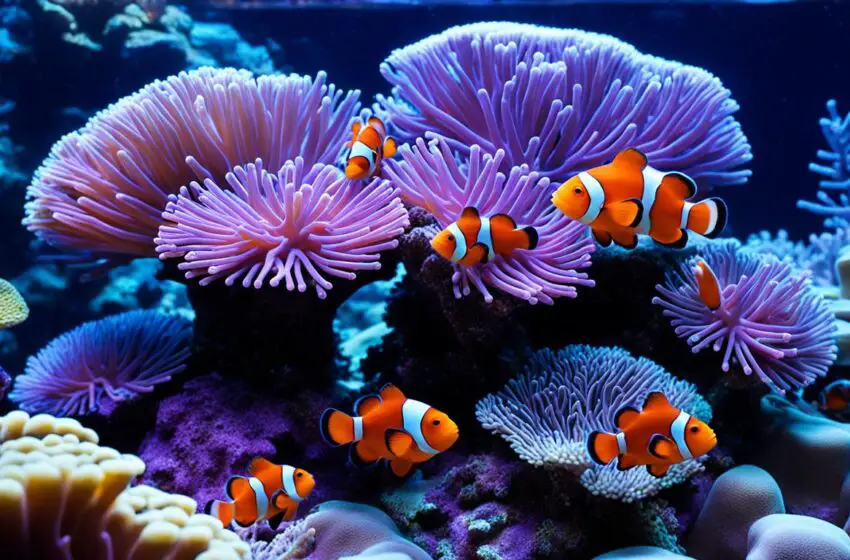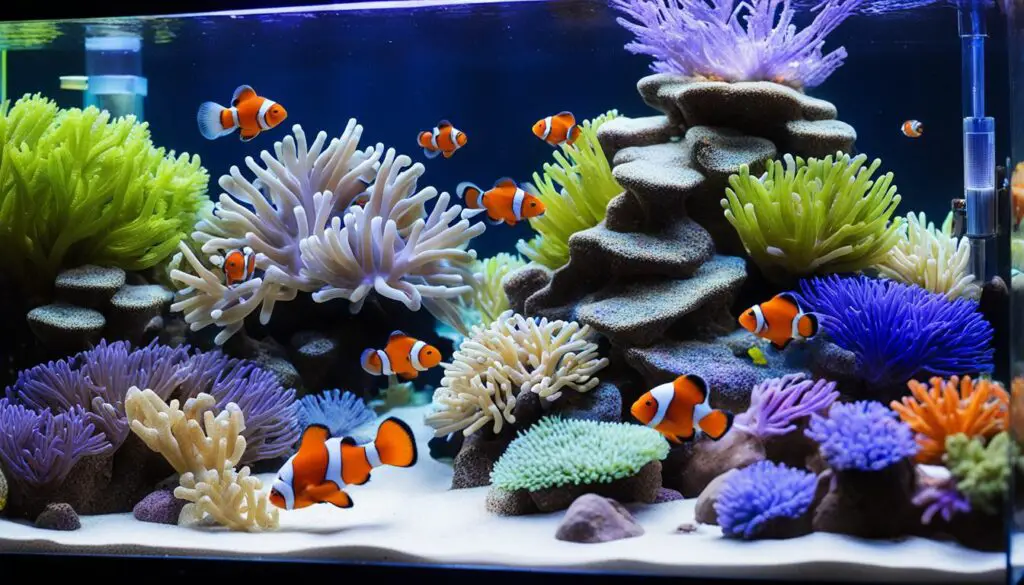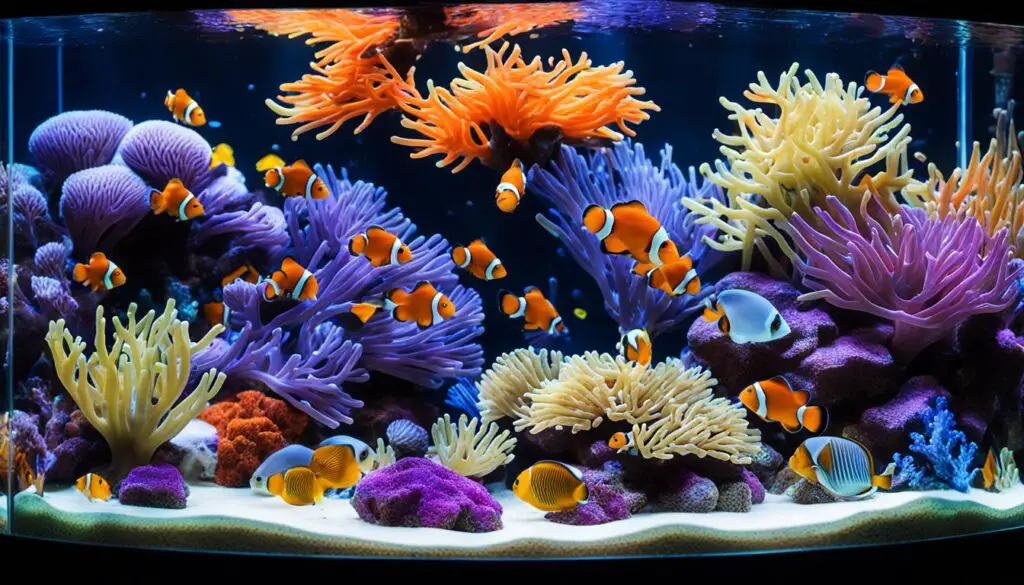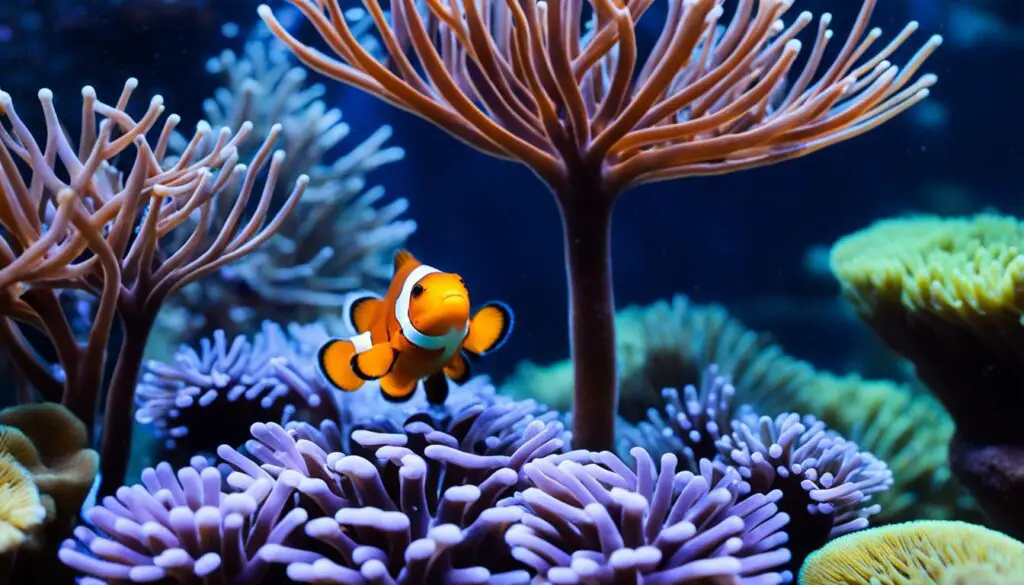Clownfish Tank Conservation Challenges: Overcoming Obstacles

The Ocellaris clownfish, or Nemo, is well-loved by many aquarium owners. This fish comes from the warm waters of the Indo-Pacific. This area stretches from the Red Sea to the Pacific Ocean.
They have a special bond with sea anemones for protection. The fish live in the anemone’s tentacles. Their mucus protects them from the anemones’ stings, allowing them to live there.
Ocellaris clownfish mainly live in the Indian Ocean, the Red Sea, and the western Pacific. They find safety amongst different sea anemones. These anemones are their home, their defense, and their food source.
They are known for their bright orange color with white stripes. This warns off predators because the anemones they live in are venomous. When mature, they are 3-4 inches in size and live with one large male and many females in the same anemone.
These fish can live a long time, from 6 to 10 years in the wild. In captivity, they might live over 20 years. They are friendly creatures that like to interact with people.
When it comes to having babies, the biggest female becomes the male. This process is called sequential hermaphroditism. The male then looks after the eggs. This is believed to be a unique behavior among fish.
The babies, called larvae, start their lives in open water. They then find an anemone to live in permanently.
Key Takeaways:
- Ocellaris clownfish are small and colorful fish endemic to the Indo-Pacific belt.
- They create homes in sea anemones, forming a unique and symbiotic relationship.
- Ocellaris clownfish are typically found in warm, tropical waters and prefer to live among various species of sea anemones.
- These fish have a bright orange color with white stripes that warn predators of their venomous protection.
- Ocellaris clownfish are long-lived and exhibit social behavior.
Creating the Perfect Clownfish Tank: A Guide to Maintenance and Care
Setting up a clownfish tank needs thought about their natural home and habits. The aim is to make a place similar to where they live in the wild. This helps them stay healthy and live longer.
You should start with a tank of at least 30 gallons for one clownfish. Add 10 more gallons for each extra fish. This gives them enough room to swim and reduces fights over space.
Add live rock to make the tank feel like the ocean where clownfish live. These rocks offer hiding spots and look like the coral they love. A safe home is key for these fish.
“Consider introducing a compatible species of sea anemone as a host for the clownfish.”
Choosing the right sea anemone is important for clownfish happiness. Good options include Bubble Tip, Sebae, and Carpet Anemones. They make the tank look great and are places for the clownfish to hide.
Keeping the water just right is crucial for your clownfish’s health. The temperature should be 72°F to 82°F. The pH should stay 8.1-8.4, with a salinity of 1.023 to 1.025. Lower ammonia, nitrite, and nitrate levels are better. Test your water often and fix any problems fast to keep a healthy aquarium.
Clownfish eat both plants and meat, so they need a varied diet. Give them marine flakes or pellets, and add brine shrimp or mysis twice a day. Only offer as much as they can eat in 2-3 minutes to avoid too much food.
Cleaning the tank regularly is also important. Do water changes, remove extra algae and waste. A clean home means less stress and better water.
| Parameter | Optimal Range |
|---|---|
| Temperature | 72°F to 82°F |
| pH Level | 8.1-8.4 |
| Salinity (specific gravity) | 1.023 to 1.025 |
| Ammonia | Low Levels |
| Nitrite | Low Levels |
| Nitrate | Low Levels |
A good diet ensures your clownfish stay colorful and healthy. They need a wide range of proteins, essential amino acids, vitamins, and minerals.
“Ocellaris clownfish can sometimes show aggressive behavior towards other fish that come too close to their anemone.”
Clownfish are mostly friendly but may guard their anemone from other fish. Watch their behavior and make sure they have space, or choose the right friends for them in the tank.
Given the right care and space, Ocellaris clownfish can live over 20 years. By meeting their needs, you can enjoy their beauty in your aquarium for a long time.

Preserving the Clownfish through Conservation Efforts
Keeping the clownfish’s natural home safe is key for their future. In the Indo-Pacific, these fish face problems like losing their homes, pollution, and changing climates. We must protect the coral reefs they live in to keep their numbers up.
Conservation works are critical for protecting clownfish. Things like creating marine areas where they are safe, fishing responsibly, and making people care about the oceans are crucial. Encouraging people to learn about why these fish matter helps, too. This includes teaching about the fish’s role in the environment and why saving them is essential.
Back the groups trying to save the seas and their creatures to help the clownfish. Using fish that are reared in tanks instead of taken from the wild is a big step. Also, keeping an eye on how many fish are around and what they need can guide how we save them.
Working together is critical for clownfish to live on. Scientists, makers of rules, people who work on saving nature, and everyone else must join forces. This way, we can help the clownfish and protect the vast water world they live in.
FAQ
What are the key facts about Ocellaris clownfish?
Ocellaris clownfish, or Nemos, are small, colorful fish loved by many. They come from warm, coral-filled areas in the Indo-Pacific. These fish live with sea anemones, gaining protection from their stings with a mucus coating.
Where are Ocellaris clownfish typically found?
Ocellaris clownfish live in the warm waters of the Indian Ocean and more. They like to hide, eat, and live around various sea anemones.
How big do Ocellaris clownfish grow?
As full-grown adults, Ocellaris clownfish reach just 3-4 inches in size.
What is their lifespan?
In the wild, Ocellaris can live for 6 to 10 years. In captivity, they might see their 20th year or beyond.
How do Ocellaris clownfish reproduce?
These fish have a unique way of reproducing. The biggest female in a group changes into a male. After the eggs are laid, the male cares for and protects them.
What is the care required for setting up a tank for clownfish?
Setting up a tank for clownfish means mimicking their natural home. A 30-gallon tank is good for one. Add 10 gallons per additional fish. Include live rocks and sea anemones.
The right water conditions are critical. Keep it at the correct temperature, pH, and salinity. Test the water often and do regular care to keep the fish happy and healthy.
What should I feed Ocellaris clownfish?
Feed your Ocellaris clownfish marine flakes and pellets, plus brine shrimp. They eat twice a day. Only give them food they can eat in 2-3 minutes to avoid overfeeding.
How do Ocellaris clownfish behave in a tank?
Ocellaris clownfish can be protective over their anemones. They’re usually calm and friendly with their own kind. They enjoy human interaction and exploring their tank.
How can I contribute to the conservation of clownfish?
Helping clownfish survival means protecting their natural homes. Buy fish that are bred in captivity. Support groups working on ocean conservation. Practice keeping your aquarium in ways that help the environment.
Source Links
- https://www.tfhmagazine.com/articles/saltwater/a-marine-aquarium-in-progress-part-3-challenges-and-triumphs
- https://worldanimalsfoundation.org/ocellaris-clownfish/
- https://www.taiwan-panorama.com/en/Articles/Details?Guid=b24c099f-da5e-4006-b722-e68306fdaffc&CatId=9&postname=No Laughing Matter:Taiwan Races to Save the Clownfish



